Analysis of the Situation of Social Public Procurement of Works at the Valencian Region (Spain)
Abstract
1. Introduction
2. Background
2.1. Literature Review
2.2. Social Procurement in the Academic Literature in Spain
2.3. Social Clauses in the Framework Normative of Spain
2.4. The Structure of the Valencian Region
3. Materials and Methods
3.1. Measurement Technique: Content Analysis
3.2. Sample Selection
3.3. Characteristics of the Sample
4. Results
- Di is the Drop of bidder i (expressed in %)
- Bi is the Bid (expressed in €)
- Pt is the Tender price (expressed in €)
5. Discussion
6. Conclusions
Author Contributions
Funding
Institutional Review Board Statement
Informed Consent Statement
Data Availability Statement
Conflicts of Interest
Appendix A
| Criteria | Description |
|---|---|
| Health and Safety | Specific report on health and safety prevention on the site. Organization of prevention and safety on site: preventive organization chart, preventive resources, coordination with subcontractors and self-employed workers. Systems for participation of contractor and subcontractor personnel. Training and information processes to be developed. Review of the Health and Safety Study with indication of deficiencies and possible improvements. Analysis of possible emergency situations: measures to be adopted, relations to be organized with external services to guarantee their speed and efficiency. |
| Health and Safety report | The systems of staff participation, the training and information processes which are carried out at the expense of the bidder during the work, the internal establishment of the safety and health measures of the proposed contractor and subcontractors will be assessed. Likewise, the analysis of the Health and Safety Study carried out by the bidders will be assessed, as well as the improvements proposed, which, in the event of the contract being awarded, must be compulsorily incorporated into the Health and Safety Plan. |
| Job creation for people with difficulties to access to the labour market | In this section the bidder will indicate the number of people he undertakes to hire for the execution of the contract, indicating the full working days for which each of them will be hired, and meeting the following requirements:
|
| Social Communication | In this section the bidders shall indicate the amount they undertake to allocate for the social communication of the work, which may not exceed 1% of the amount of the material execution of the work. This communication will be destined for the maintenance of uninterrupted information to all those affected by the works in order to cause the least harm to the citizens and to the good execution of the works (mobility, accessibility, effects on third parties, environmental effects, etc.). |
| Number of unemployed or disabled people to be hired | Without description |
| Health and Safety | Improvements in health and safety and traffic safety, above and beyond the legal or normal conditions for the correct execution of works. |
| Health and Safety | Report setting out the measures proposed by the company to improve health and safety on the site. |
| Technical and auxiliary resources and prevention measures | Without description |
References
- United Nations. Sustainable Procurement: Buying for a Better World. In The United Nations Sustainable Procurement Guide—Resource Book of the UN Sustainable Procurement Training; UN: Geneva, Switzerland, 2008. [Google Scholar]
- PricewaterhouseCoopers Significant and Ecofys. Collection of Statistical Information on Green Public Procurement in EU—Report on Data Collection Result; PricewaterhouseCoopers, Significant and Ecofys: Amsterdam, The Netherlands, 2009. [Google Scholar]
- Wong, J.M.W.; Chiang, Y.H.; Ng, T.S. Construction and economic development: The case of Hong Kong. Constr. Manag. Econ. 2008, 26, 815–826. [Google Scholar] [CrossRef]
- Zhu, Q.; Geng, Y.; Sarkis, J. Motivating green public procurement in China: An individual level perspective. J. Environ. Manag. 2013, 126, 85–95. [Google Scholar] [CrossRef] [PubMed]
- Tarantini, M.; Dominici Loprieno, A.; Porta, P.L. A life cycle approach to Green Public Procurement of building materials and elements: A case study on windows. Energy 2011, 36, 2473–2482. [Google Scholar] [CrossRef]
- Erdmenger, C. Public purchasing: A new, old policy tool. In Buying into the Environment: Experiences, Opportunities and Potential for Eco-Procurement; ICLEI: Sheffield, UK, 2003; pp. 9–17. [Google Scholar]
- Walker, H.; Brammer, S. Sustainable procurement in the United Kingdom public sector. Supply Chain Manag. An Int. J. 2009, 14, 128–137. [Google Scholar] [CrossRef]
- Kalubanga, M. Sustainable Procurement: Concept, and Practical Implications for the Procurement Process. Int. J. Econ. Manag. Sci. 2012, 1, 01–07. [Google Scholar]
- Taipale, K. From light green to sustainable buildings, in the Worldwatch Institute. In State of the World 2012—Moving toward Sustainable Prosperity; The World watch Institute: Washington, DC, USA, 2012; pp. 129–136. [Google Scholar]
- Ruparathna, R.; Hewage, K. Sustainable procurement in the Canadian construction industry: Challenges and benefits. Can. J. Civ. Eng. 2015, 426, 417–426. [Google Scholar] [CrossRef]
- Montalbán, L.; Ballesteros-Pérez, P.; Sanz, A.; Pellicer, E. Sustainable Public Procurement: Barriers and drawbacks. In Proceedings of the 21st International Congress on Project Management and Engineering, Cádiz, Spain, 12–14 July 2017; pp. 571–582. [Google Scholar]
- Igarashi, M.; De Boer, L.; Michelsen, O. Investigating the anatomy of supplier selection in green public procurement. J. Clean. Prod. 2015, 108, 442–450. [Google Scholar] [CrossRef]
- Testa, F.; Grappio, P.; Gusmerotti, N.M.; Iraldo, F.; Frey, M. Examining green public procurement using content analysis: Existing difficulties for procurers and useful recommendations. Environ. Dev. Sustain. 2016, 18, 197–219. [Google Scholar] [CrossRef]
- Fuentes-Bargues, J.L.; González-Cruz, M.C.; González-Gaya, C. Environmental Criteria in the Spanish Public Works Procurement Process. Int. J. Environ. Res. Public Health 2017, 14, 204. [Google Scholar] [CrossRef]
- Cheng, W.; Appolloni, A.; D’Amato, A.; Zhu, Q. Green Public Procurement, missing concepts and future trend—A critical review. J. Clean. Prod. 2018, 176, 770–784. [Google Scholar] [CrossRef]
- Gulie, M. Green Public Procurement in Romania. Qual. Access Success 2019, 20, 295–301. [Google Scholar]
- Montalbán-Domingo, L.; García-Segura, T.; Amalia Sanz, M.; Pellicer, E. Social sustainability criteria in public work procurement: An international perspective. J. Clean. Prod. 2018, 198, 1355–1371. [Google Scholar] [CrossRef]
- Bernal, R.; San-José, L.; Retolaza, J.L. Improvement actions for a more social and sustainable public procurement: A Delphi Analysis. Sustainability 2019, 11, 4069. [Google Scholar] [CrossRef]
- Said, H.; Berger, L. Future trends of sustainability design and analysis in construction industry and academia. Pract. Period. Struc. Des. Cons. 2013, 19, 77–88. [Google Scholar] [CrossRef]
- Parkin, S. Sustainable development: The concept and the practical challenge. Proc. Inst. Civ. Eng. 2000, 138, 3–8. [Google Scholar] [CrossRef]
- Kaye, L.; Gabriela, N.; Nijaki, L.K. Procurement for sustainable local economic development. Int. J. Public Sect. Manag. 2012, 25, 133–153. [Google Scholar] [CrossRef]
- Sierra, L.A.; Pellicer, E.; Yepes, V. Social sustainability in the life cycle of Chilean public infrastructure. J. Cons. Eng. Manag. 2016, 142, 05015020. [Google Scholar] [CrossRef]
- Appolloni, A.; D’Amato, A.; Cheng, W. Is Public Procurement Going Green? Experiences and Open Issues. In The Applied Law and Economics of Public Procurement. The Economics of Legal Relationships; Piga, G., Treumer, S., Eds.; Routledge: London, UK, 2012. [Google Scholar]
- Ma, Y.; Liu, Y.; Appolloni, A.; Liu, J. Does green public procurement encourage firm’s environmental certification practice? The mediation role of top management support. Corp. Soc. Responsib. Environ. Manag. 2020, 1–16. [Google Scholar] [CrossRef]
- Zuo, J.; Jin, X.-H.; Flynn, L. Social sustainability in construction: An explorative study. Int. J. Cons. Manag. 2012, 12, 51–63. [Google Scholar] [CrossRef]
- Loosemore, M. Social procurement in UK construction projects. Int. J. Proj. Manag. 2016, 34, 133–144. [Google Scholar] [CrossRef]
- Mc Crudden, C. Using public procurement to achieve social outcomes. Nat. Resour. Forum. 2004, 28, 257–267. [Google Scholar] [CrossRef]
- United Kingdom. Social Value Act. Available online: https://cnmc.es/file/123729 (accessed on 20 February 2020).
- European Union. Directive 2014/24/EU of the European Parliament and of the Council of 26 February 2014 on public procurement and repealing Directive 2004/18/EC. Off. J. Eur. Union 2014, 94, 65–234. [Google Scholar]
- Loosemore, M. Building a new third construction sector through social enterprise. Cons. Manag. Econ. 2015, 33, 724–739. [Google Scholar] [CrossRef]
- Petersen, D.; Kadefors, A. Social Procurement and Employment Requirements in Construction. In Proceedings of the 32nd Annual ARCOM Conference, Manchester, UK, 5–7 September 2016; pp. 997–1006. [Google Scholar]
- Sporrong, J.; Kadefors, A. Municipal consultancy procurement: New roles and practices. Build. Res. Inf. 2014, 42, 616–628. [Google Scholar] [CrossRef]
- European Commission. Commission Recommendation (EU) 2017/1805 on the professionalization of public procurement—Building an architecture for the professionalization of public procurement. Off. J. Eur. Union 2017, L259, 28–31. [Google Scholar]
- Sutherland, V.; McTier, A.; Glass, A.; Mc Gregor, A. Analysis of The Impact and Value of Community Benefit Clauses in Procurement, Glasgow. Training and Employment Research Unit (TERU); University of Glasgow: Glasgow, UK, 2015. [Google Scholar]
- Wright, T. New development: Can ‘social value’ requirements on public authorities be used in procurement to increase women’s participation in the UK construction industry? Pub. Money Manag. 2015, 35, 135–140. [Google Scholar] [CrossRef]
- Barraket, J.; Weissman, J. Social Procurement and Its Implications for Social Enterprise: A Literature Review; Queensland University of Technology: Brisbane, Australia, 2009. [Google Scholar]
- Comisión Nacional de los Mercados y la Competencia (CNMC). PRO/CNMC/001/15: Análisis de la Contratación Pública en España: Oportunidades de Mejora Desde el punto de Vista de la Competencia. Available online: https://cnmc.es/file/123729/download (accessed on 20 February 2020).
- Wontner, K.L.; Walker, H.; Harris, I.; Lynch, J. Maximising “Community Benefits” in public procurement: Tensions and trade-offs. Int. J. Oper. Prod. Manag. 2020. [Google Scholar] [CrossRef]
- Akenroye, T.O. An appraisal of the use of social criteria in public procurement in Nigeria. J. Pub. Procure. 2013, 13, 364–397. [Google Scholar] [CrossRef]
- Hueskes, M.; Verhoest, K.; Block, T. Governing public-private partnerships for sustainability. An analysis of procurement and governance practices of PPP infrastructure projects. Int. J. Proj. Manag. 2017, 35, 1184–1195. [Google Scholar] [CrossRef]
- Devolver, S.; Block, T. Transition thinking incorporated: Towards a new discussion framework on sustainable urban projects. Sustainability 2015, 7, 3269–3289. [Google Scholar] [CrossRef]
- Fuentes-Bargues, J.L.; González-Gaya, C.; González-Cruz, M.C. La contratación pública de obras: Situación actual y puntos de mejora. Inf. Cons. 2015, 67, e058. [Google Scholar] [CrossRef]
- Tague, N.R. The Quality Toolbox; SAQ Quality Press: Milwaukee, AZ, USA, 2004. [Google Scholar]
- Martínez-Fons, D. Cláusulas Sociales, Libre Competencia Y Contratación Pública; Fundación Alternativas: Madrid, Spain, 2009. [Google Scholar]
- García, J.M.; Bakaikoa, B.B. El papel de la económica social en la contratación pública del Gobierno vasco entre 2010 y 2013. CIRIEC-España Rev. Econ. Pub. Soc. Coop. 2014, 82, 207–232. [Google Scholar]
- Erausin-Tolosa, A.; Zurbano Irizar, M.; Martínez Tola, E. Contrataciones públicas en economía social: Un estudio del caso de la Universidad del País Vasco (UPV/EHU). CIRIEC-España Rev. Econ. Pub. Soc. Coop. 2017, 89, 55–79. [Google Scholar] [CrossRef]
- Diz, I.; Nogueira, A. Las cláusulas sociales en la contratación pública: ¿Escudo contra los recortes de derechos sociales? Rev. Esp. Sociol. 2017, 26, 77–95. [Google Scholar]
- Muñoz Machado, S. Analysis of the social clauses in the new Public Sector Contracts Law. In Proceedings of the Social Commitments in the New Public Sector Contracts Law as a Tool to Achieve Greater Efficiency in Public Contracting, Madrid, Spain, 19 June 2018. INAP (In Spanish). [Google Scholar]
- Mendoza Jiménez, J.; Hernández López, M.; Franco Escobar, S.E. Sustainable Public Procurement: From Law to Practice. Sustainability 2019, 11, 6388. [Google Scholar] [CrossRef]
- European Union. Directive 2004/18/EC of the European Parliament and of the Council of 31st March 2004, on the coordination of procedures for the award of public works contracts, public supply contracts and public service contracts. Off. J. Eur. Union 2004, L134, 114–240. [Google Scholar]
- BOE. Law 30/2007 of 30th October on Public Contracts; BOE: Madrid, Spain, 2007; pp. 44336–44436. (In Spanish) [Google Scholar]
- BOE. Royal Decree 3/2011 of 14th November that Approves the Restated Text of the Law on Public Sector Contracts; BOE: Madrid, Spain, 2011; pp. 117729–117914. (In Spanish) [Google Scholar]
- BOE. Law 9/2017 of 8th November on Public Contracts, Transposing European Parliament and Council Directives 2014/23/EU and 2014/24/EU of 26th February into Spanish Law; BOE: Madrid, Spain, 2017; pp. 107714–108007. (In Spanish) [Google Scholar]
- European Union. Directive 2014/23/EU of the European Parliament and of the Council of 26th February, on the award of concession contracts. Off. J. Eur. Union 2014, 94, 1–64. [Google Scholar]
- European Union. Directive 2014/25/EU of the European Parliament and of the Council of 26th February on procurement by entities operating in the water, energy, transport, and postal services sectors and repealing Directive 2004/17/EC. Off. J. Eur. Union 2014, 94, 243–374. [Google Scholar]
- Generalitat Valenciana (GVA). Guía Práctica Para la Inclusión de Cláusulas de Responsabilidad Social en la Contratación y en Subvenciones de la Generalitat y su Sector Público. Available online: http://participacio.gva.es/documents/162282364/162406386/Gu%c3%ada+de+Cl%c3%a1usulas+de+Responsabilidad+Social/4420cf90-8d86-47b9-9d7c-9cddc4e0dfe9 (accessed on 24 August 2020).
- Generalitat Valenciana (GVA). II Guía Práctica Para la Inclusión de Cláusulas de Responsabilidad Social en la Contratación de la Generalitat y su Sector Público. Available online: http://participacio.gva.es/documents/162282364/165197951/DEFINITIVAII_GUIA+ADAPTADA_TRAS_LCE.pdf/a2980fcf-7455-4172-aad5-d64397b76f86 (accessed on 24 August 2020).
- Castellon Council. Instrucción Para la Inclusión de Criterios Sociales en la Contratación Pública. Available online: http://www.castello.es/archivos/1169/Anuncio_BOP_Instruccion.pdf (accessed on 24 August 2020).
- Valencia Council. Instrucción de Contratación Pública Responsable y Guía Inclusiva de Clausulado Social y Sistema de Verificación de Cumplimiento. Available online: http://www.valencia.es/ayuntamiento/tablon_anuncios.nsf/0/3FAB36B5DD89A226C12583A90046F3E8/$FILE/20190225%20INSTRUCCIO%CC%81%20CONTRACTACIO%CC%81%20PU%CC%81BLICA%20I%20GUIA%20CLAUSULAT%20SOCIAL.pdf?OpenElement&lang=1 (accessed on 24 August 2020).
- Portal Estadístico de la Generalitat Valenciana. Available online: http://www.pegv.gva.es/es/inicio (accessed on 20 March 2019).
- Kippo-Edlund, P.; Hauta-Heikkilä, H.; Miettinen, H.; Nissinen, A. Measuring the Environmental Soundness of Public Procurement in Nordic Countries: Tema Nord 2005:505, Nordic Council of Ministers, Copenhagen. Available online: http://norden.diva-portal.org/smash/get/diva2:702135/FULLTEXT01.pdf (accessed on 30 April 2020).
- Nissinen, A.; Parikka-Alhola, K.; Rita, H. Environmental criteria in the public purchases above the EU threshold values by three Nordic countries: 2003 and 2005. Ecol. Econ. 2009, 68, 1838–1849. [Google Scholar] [CrossRef]
- Stanford, M.; Molenaar, K.R.; Sheeran, K. Application of indefinite delivery e indefinite quantity construction strategies at the federal level. J. Manag. Eng. 2016, 32, 4016011. [Google Scholar] [CrossRef]
- Kerlinger, F.H. Foundations of Behavioral Research: Educational and Psychology Inquiry; Holt Rinehart & Winston: New York, NY, USA, 1964. [Google Scholar]
- Fernández, F. El análisis de contenido como ayuda metodológica para la investigación. Rev. Cienc. Soc. 2002, 96, 35–53. [Google Scholar]
- Neuendorf, K.A. The Content Analysis Guidebook; Sage Publications: Thousand Oaks, CA, USA, 2002. [Google Scholar]
- Rodrigues, M.; Mendes, L. Mapping of the literature on social responsibility in the mining industry: A systematic literature review. J. Clean. Prod. 2018, 181, 88–101. [Google Scholar] [CrossRef]
- Plataforma de Contratación del Sector Público. Available online: https://contrataciondelestado.es/wps/portal/licitaciones (accessed on 17 December 2017).
- Plataforma de Contratación de la Generalitat Valenciana. Available online: http://www.contratacion.gva.es/WebContrataP/filtro.jsp?MODO=P (accessed on 15 May 2018).
- Värnas, A.; Balfors, B.; Faith-Ell, C. Environmental consideration in procurement of construction contracts: Current practice, problems, and opportunities in green procurement in the Swedish construction industry. J. Clean. Prod. 2009, 17, 1214–1222. [Google Scholar] [CrossRef]
- Fuentes-Bargues, J.L.; Ferrer-Gisbert, P.S.; González-Cruz, M.C. Analysis of Green Public Procurement of Works by Spanish Public Universities. Int. J. Environ. Res. Public Health 2018, 15, 1888. [Google Scholar] [CrossRef]
- European Union. Common Procurement Vocabulary. Available online: https://https://ec.europa.eu/growth/single-market/public-procurement/digital/common-vocabulary_en (accessed on 30 April 2020).
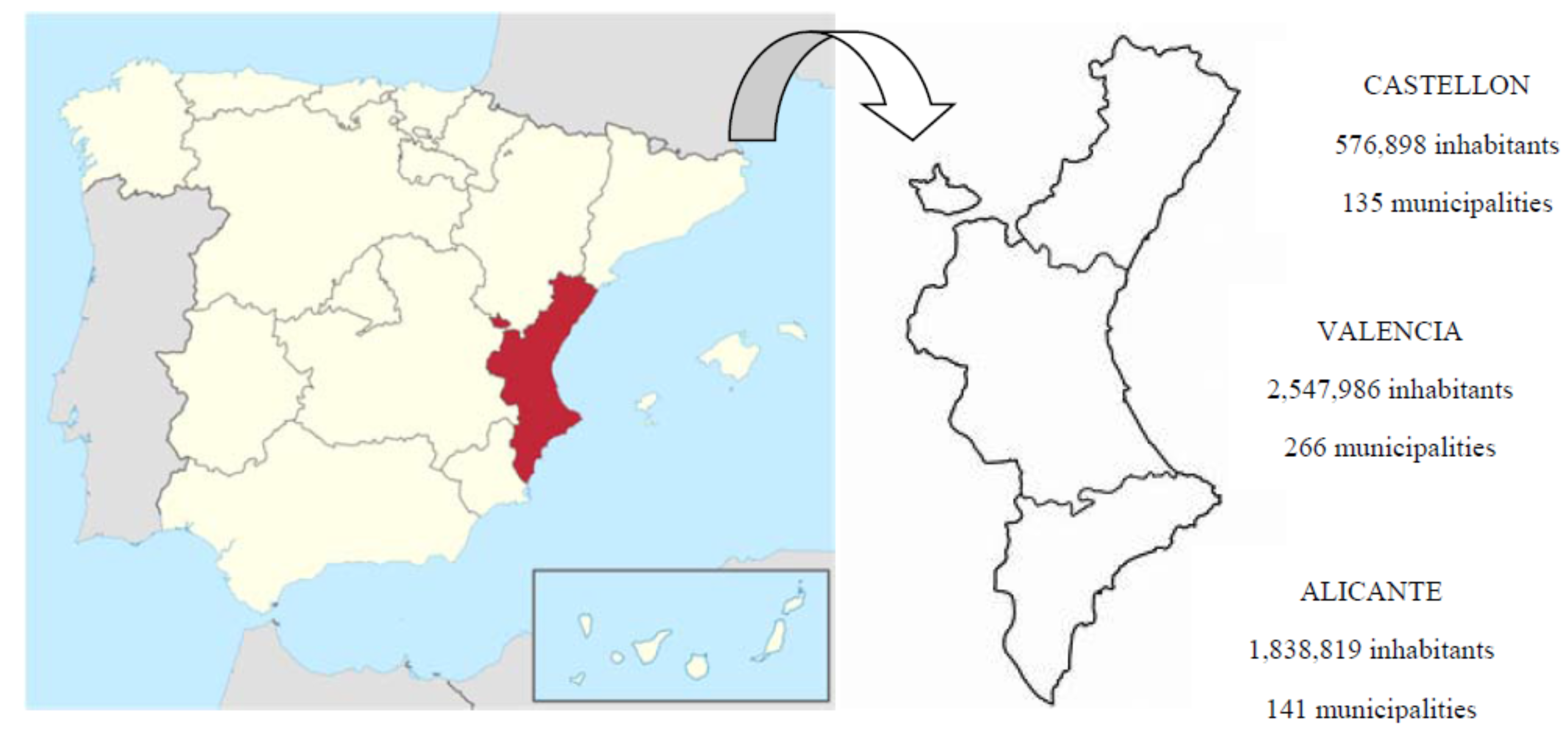
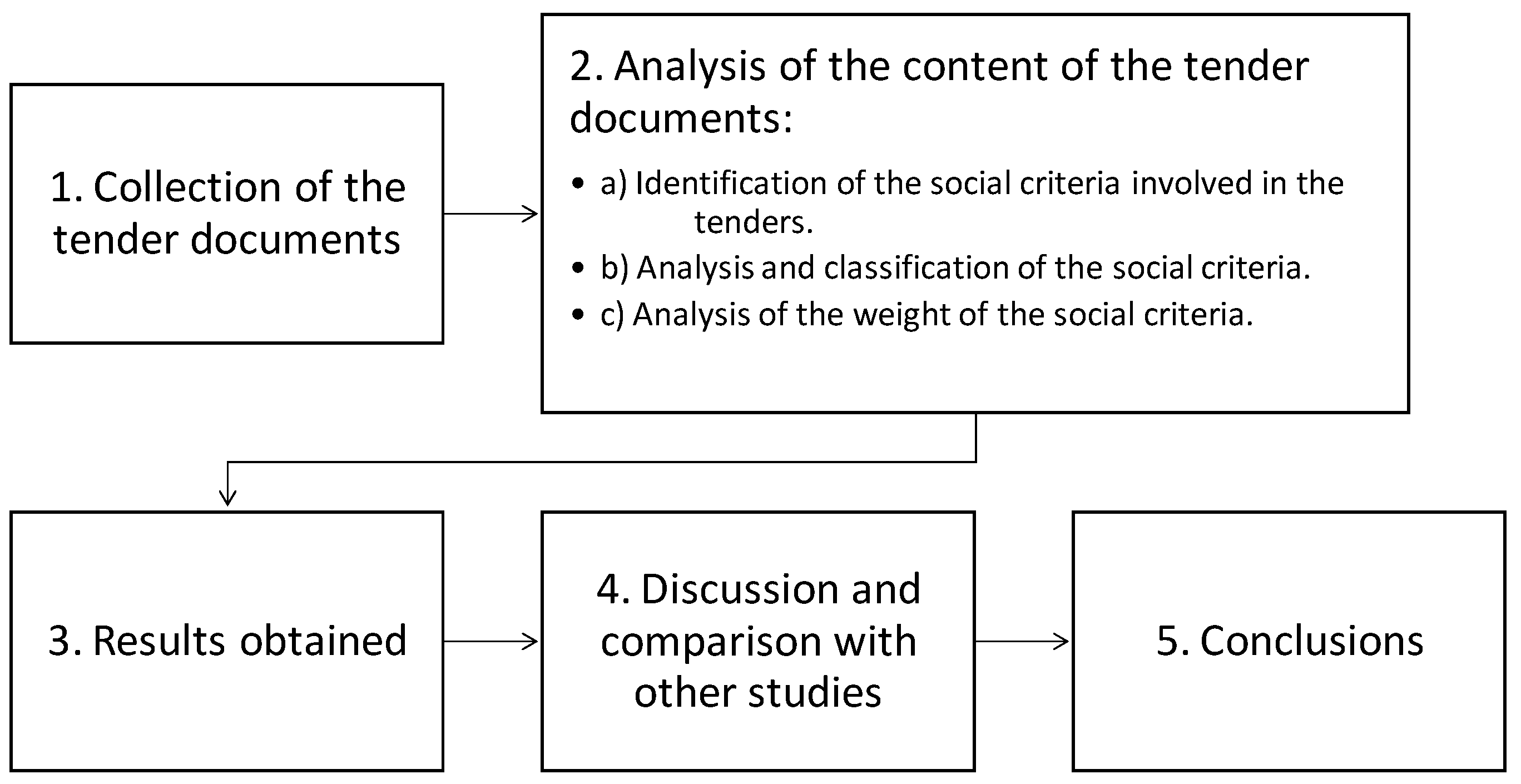
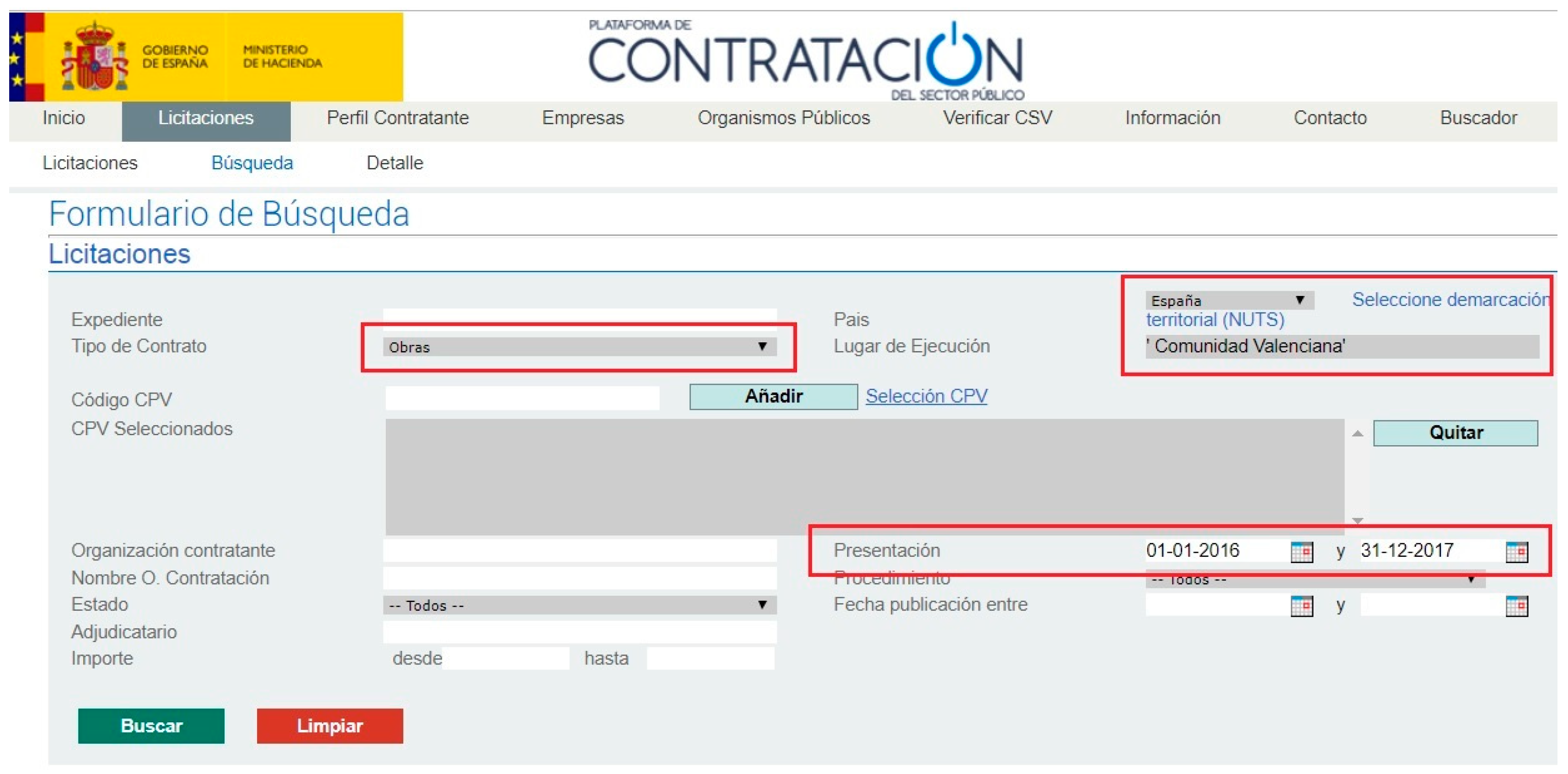
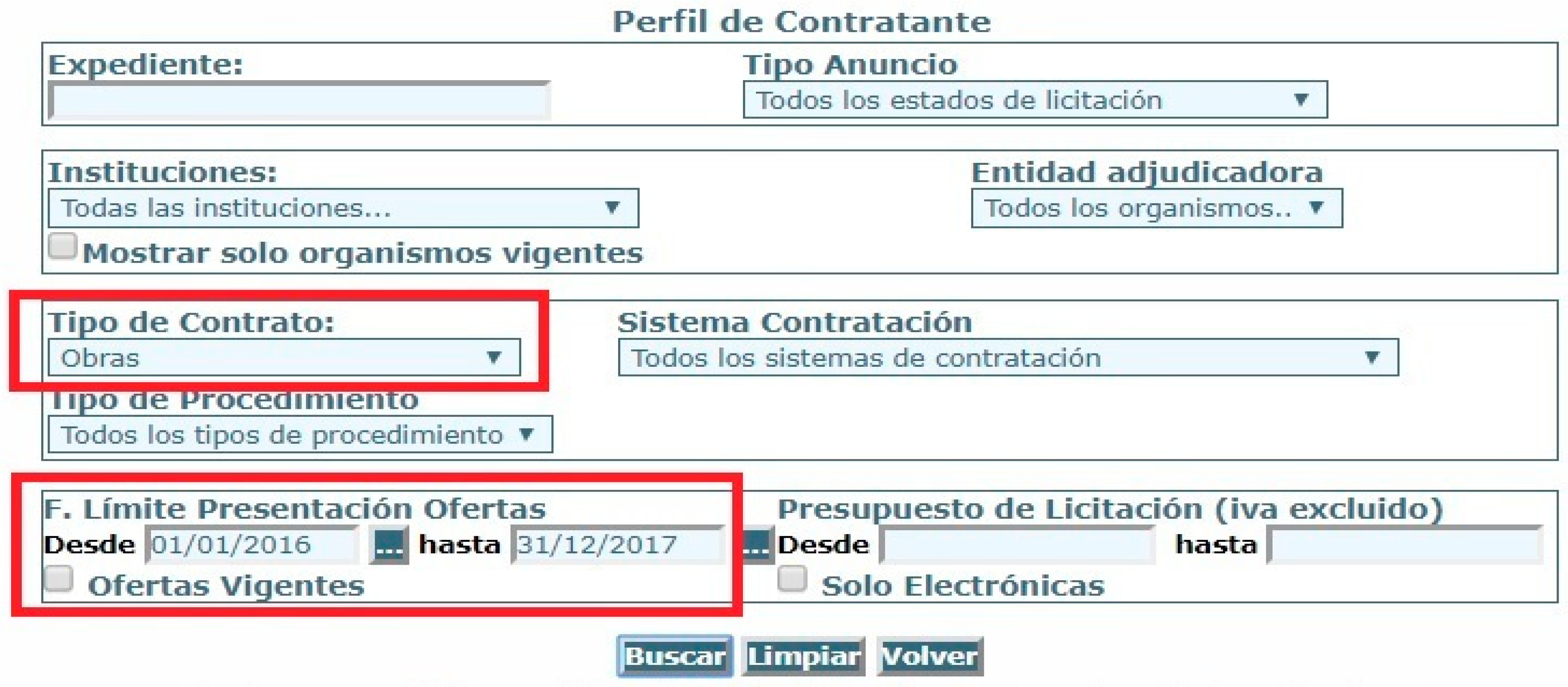

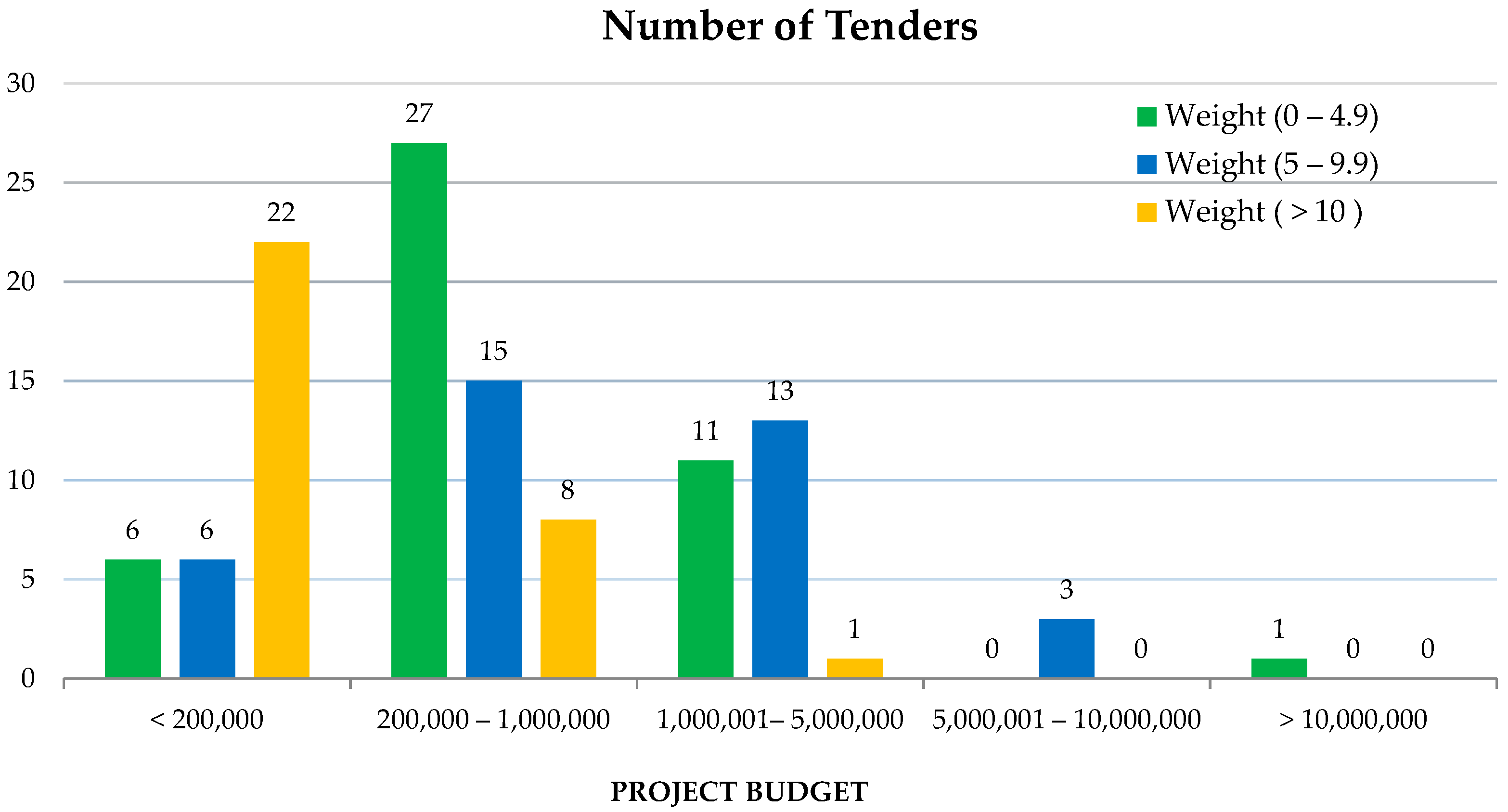
| Id | Contracting Authorities | NB | NC | NT |
|---|---|---|---|---|
| 103 | Valencia Regional Council for Housing, Public Works, and Infrastructure | 17 | 52 | 69 |
| 121 | Alicante Provincial Council | 6 | 51 | 57 |
| 12 | Alicante City Council | 10 | 36 | 46 |
| 96 | Council for Agriculture, Environment, Climate Change and Rural Development | 1 | 43 | 44 |
| 84 | Valencia City Council | 16 | 27 | 43 |
| 98 | Council for Education, Research, Culture and Sport | 36 | 0 | 36 |
| 6 | Castellon City Council | 12 | 21 | 33 |
| 120 | Valencia Provincial Council | 0 | 32 | 32 |
| 125 | Railways of the Generalitat Valenciana | 5 | 16 | 21 |
| 20 | Benidorm City Council | 6 | 15 | 21 |
| 74 | San Vicente del Raspeig City Council | 8 | 12 | 20 |
| 32 | Elche City Council | 7 | 12 | 19 |
| 47 | Lliria City Council | 8 | 11 | 19 |
| 57 | Onteniente City Council | 5 | 13 | 18 |
| 64 | Picassent City Council | 5 | 13 | 18 |
| 94 | City of Arts and Sciences | 17 | 0 | 17 |
| 61 | Paterna City Council | 8 | 7 | 15 |
| 5 | Alzira City Council | 7 | 7 | 14 |
| 139 | University of Alicante | 12 | 2 | 14 |
| 59 | Oropesa del Mar City Council | 5 | 8 | 13 |
| 42 | Ibi City Council | 5 | 6 | 11 |
| 27 | Catarroja City Council | 5 | 6 | 11 |
| 104 | General University Hospital of Valencia | 10 | 0 | 10 |
| 129 | Valencian Institute for Social Action | 10 | 0 | 10 |
| Project Budget (€) | NB | NC | NT |
|---|---|---|---|
| <200,000 | 207 | 257 | 464 |
| 200,000–1,000,000 | 152 | 251 | 403 |
| 1,000,001–5,000,000 | 30 | 52 | 82 |
| 5,000,001–10,000,000 | 6 | 2 | 8 |
| >10,000,001 | 0 | 10 | 10 |
| Execution Time (Months) | NB | NC | NT |
|---|---|---|---|
| <6 | 313 | 455 | 768 |
| 6–12 | 55 | 75 | 130 |
| 12–18 | 10 | 9 | 19 |
| 18–24 | 12 | 7 | 19 |
| >24 | 2 | 19 | 21 |
| without data | 3 | 7 | 10 |
| CPV | Frequency | Description |
|---|---|---|
| 45,200,000 | 80 | Works for complete or partial construction and civil engineering work |
| 45,000,000 | 71 | Construction work |
| 45,233,120 | 41 | Road construction works |
| 45,233,222 | 40 | Paving works |
| 45,210,000 | 35 | Building construction work |
| 45,233,252 | 33 | Street paving works |
| 45,233,140 | 31 | Road works |
| 45,220,000 | 25 | Engineering works and construction works |
| 45,215,200 | 21 | Construction works of buildings for social services |
| 45,212,200 | 21 | Construction work for sports facilities |
| 45,215,140 | 20 | Hospitals |
| 45,310,000 | 20 | Electrical installation work |
| Description of the Social Criteria | NSCB | NSCC | NSCT |
|---|---|---|---|
| Cultural Heritage | - | - | - |
| Employment | 10 | 17 | 27 |
| Health and Safety | 45 | 38 | 83 |
| Participation of local companies | - | - | - |
| Professional ethics | - | - | - |
| Public Participation | 10 | 16 | 26 |
| Training | - | - | - |
| User’s Impact | - | - | - |
| Geographical Scope in the Valencian Region of the Contracting Authority (GSCV) | SC | SC/N (%) |
|---|---|---|
| Alicante province | 10 | 3.8 |
| Castellon province | 29 | 23.8 |
| Valencia province | 16 | 4.7 |
| Valencian region | 58 | 24.1 |
| Geographical Scope of the Contracting Authority (GS) | Building Subsector | Civil Engineering Subsector | Total | ||||||
|---|---|---|---|---|---|---|---|---|---|
| SCB | SCB/NB (%) | SCB/SCT (%) | SCC | SCC/NC (%) | SCC/CT (%) | SCT | SCT/NT (%) | SCT/∑SCT (%) | |
| Local | 24 | 10.6 | 51.1 | 23 | 6.4 | 48.9 | 47 | 8.0 | 41.6 |
| Provincial | 1 | 1.9 | 12.5 | 7 | 8.1 | 87.5 | 8 | 5.8 | 7.1 |
| Regional | 31 | 26.7 | 53.4 | 27 | 21.6 | 46.6 | 58 | 24.1 | 51.3 |
| ID | Contracting Authorities | GS | SCB | SCB/NB (%) | SCC | SCC/NC (%) | SCT | SCT/NT (%) |
|---|---|---|---|---|---|---|---|---|
| 103 | Valencia Regional Council for Housing, Public Works, and Infrastructure | R | 12 | 70.6 | 18 | 34.6 | 30 | 43.5 |
| 6 | Castellon City Council | L | 10 | 83.3 | 16 | 76.2 | 26 | 78.8 |
| 98 | Council for Education, Research, Culture and Sport | R | 13 | 35.1 | - | - | 13 | 35.1 |
| 121 | Alicante provincial Council | P | - | - | 7 | 13.7 | 7 | 12.3 |
| 125 | Railways of the Generalitat Valenciana | R | - | - | 6 | 37.5 | 6 | 28.6 |
| 123 | Infrastructure Office of the Generalitat | R | 6 | 85.7 | - | - | 6 | 85.7 |
| 141 | Polytechnic University of Valencia | L | 4 | 100 | - | - | 4 | 80 |
| 142 | University of Valencia | L | 4 | 100 | - | - | 4 | 100 |
| 96 | Council for Agriculture, Environment, Climate Change and RuralDevelopment | R | 0 | 0 | 3 | 7.0 | 3 | 6.8 |
| 21 | Betxi City Council | L | 2 | 100 | 0 | 0 | 2 | 50 |
| 30 | Denia City Council | L | - | - | 2 | 50 | 2 | 50 |
| 130 | Valencian Institute of Modern Art | L | 2 | 100 | - | - | 2 | 100 |
| 16 | Bellreguard City Council | L | 0 | 0 | 1 | 50 | 1 | 25 |
| 38 | Gandia City Council | L | 0 | 0 | 1 | 20 | 1 | 16.7 |
| 46 | La Núcia City Council | L | - | - | 1 | 100 | 1 | 100 |
| 66 | Quart Poblet City Council | L | 0 | 0 | 1 | 100 | 1 | 50 |
| 72 | San Rafael del Río City Council | L | 1 | 100 | - | - | 1 | 100 |
| 92 | Xirivella City Council | L | 1 | 50 | - | - | 1 | 50 |
| 109 | Valencia 2007 Company | L | 0 | 0 | 1 | 33.3 | 1 | 25 |
| 114 | Requena Health Department | P | 1 | 100 | - | - | 1 | 100 |
| Type of Administrative Procedure | GS | Tenders with Social Criteria | Total Tenders | Tenders with Social Criteria/Total tenders (%) |
| Ordinary | L | 21 | 403 | 5.2 |
| P | 8 | 127 | 6.3 | |
| R | 57 | 227 | 25.1 | |
| Urgent | L | 26 | 184 | 14.1 |
| P | 0 | 12 | 0 | |
| R | 1 | 12 | 8.3 | |
| Emergency | L | 0 | 0 | - |
| P | 0 | 0 | - | |
| R | 0 | 2 | 0 | |
| Method of Participation | GS | Tenders with Social Criteria | Total Tenders | Tenders with Social Criteria/Total Tenders (%) |
| Open | L | 46 | 435 | 10.6 |
| P | 7 | 113 | 6.2 | |
| R | 58 | 239 | 24.3 | |
| Negotiated with advertising | L | 0 | 41 | 0 |
| P | 1 | 5 | 20 | |
| R | 0 | 1 | 0 | |
| Negotiated without advertising | L | 1 | 111 | 0.9 |
| P | 0 | 21 | 0 | |
| R | 0 | 1 | 0 |
| Project Budget (€) | SCB/NB (%) | SCC/NC (%) | SCT/NT (%) |
|---|---|---|---|
| <200,000 | 7.3 | 7.4 | 7.3 |
| 200,000–1,000,000 | 16.5 | 10.0 | 12.4 |
| 1,000,001–5,000,000 | 43.3 | 23.1 | 30.5 |
| 5,000,001–10,000,000 | 50.0 | 0.0 | 37.5 |
| >10,000,000 | - | 10.0 | 10.0 |
Publisher’s Note: MDPI stays neutral with regard to jurisdictional claims in published maps and institutional affiliations. |
© 2020 by the authors. Licensee MDPI, Basel, Switzerland. This article is an open access article distributed under the terms and conditions of the Creative Commons Attribution (CC BY) license (http://creativecommons.org/licenses/by/4.0/).
Share and Cite
Fuentes-Bargues, J.L.; Bastante-Ceca, M.J.; Ferrer-Gisbert, P.S.; González-Cruz, M.C. Analysis of the Situation of Social Public Procurement of Works at the Valencian Region (Spain). Sustainability 2021, 13, 175. https://doi.org/10.3390/su13010175
Fuentes-Bargues JL, Bastante-Ceca MJ, Ferrer-Gisbert PS, González-Cruz MC. Analysis of the Situation of Social Public Procurement of Works at the Valencian Region (Spain). Sustainability. 2021; 13(1):175. https://doi.org/10.3390/su13010175
Chicago/Turabian StyleFuentes-Bargues, José Luis, Mª José Bastante-Ceca, Pablo Sebastián Ferrer-Gisbert, and Mª Carmen González-Cruz. 2021. "Analysis of the Situation of Social Public Procurement of Works at the Valencian Region (Spain)" Sustainability 13, no. 1: 175. https://doi.org/10.3390/su13010175
APA StyleFuentes-Bargues, J. L., Bastante-Ceca, M. J., Ferrer-Gisbert, P. S., & González-Cruz, M. C. (2021). Analysis of the Situation of Social Public Procurement of Works at the Valencian Region (Spain). Sustainability, 13(1), 175. https://doi.org/10.3390/su13010175







